Green Noise vs White Noise: Which One Is Right for You?
Table of Contents
- Introduction
- What Is White Noise?
- What Is Green Noise?
- Key Differences Between Green Noise and White Noise
- Pros and Cons of Each
- Which Should You Choose?
- How to Try Green Noise and White Noise
- Frequently asked questions
- Conclusion
Introduction
When it comes to creating the perfect environment for sleep, relaxation, or focus, noise plays a bigger role than you might think. Green noise and white noise are two popular options in the world of sound therapy, each offering unique benefits for different needs.
While white noise has been a go-to for years, green noise is quickly gaining traction for its natural and soothing tones. In this post, we’ll break down the differences between these two noise types, their key characteristics, and how to choose the right one for your goals. Whether you’re looking to block distractions, relax, or improve your sleep, understanding these two options will help you make the best choice.
What Is White Noise?
Definition and Characteristics
White noise contains equal power across all frequencies audible to the human ear, creating a consistent, static-like sound. Common examples include the hum of a fan, the static of a TV, or the sound of an air conditioner. Its even distribution of sound frequencies helps mask background noise effectively.
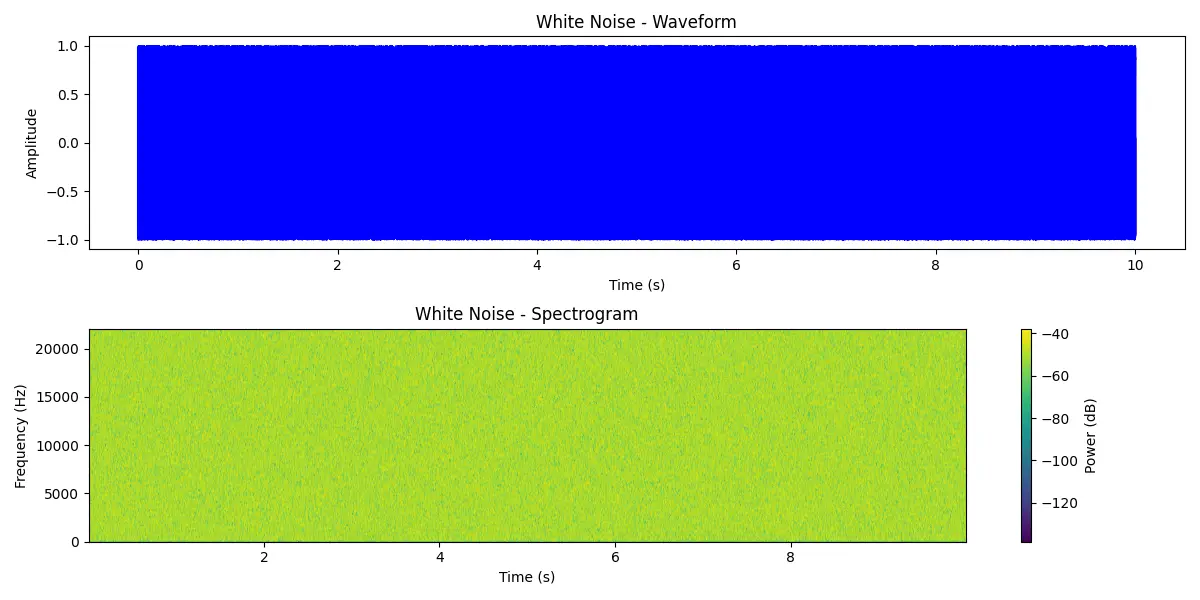
Common Use Cases
White noise is widely used for masking disruptive sounds, making it a favorite for improving sleep and concentration. Parents often rely on it to help babies sleep, and it’s also popular for maintaining privacy in offices or shared spaces.
What Is Green Noise?
Definition and Characteristics
Green noise is a balanced mix of mid-frequency sounds, often described as more natural and calming. It mimics ambient noises found in nature, such as gentle waterfalls or rustling leaves, making it ideal for relaxation and stress relief.
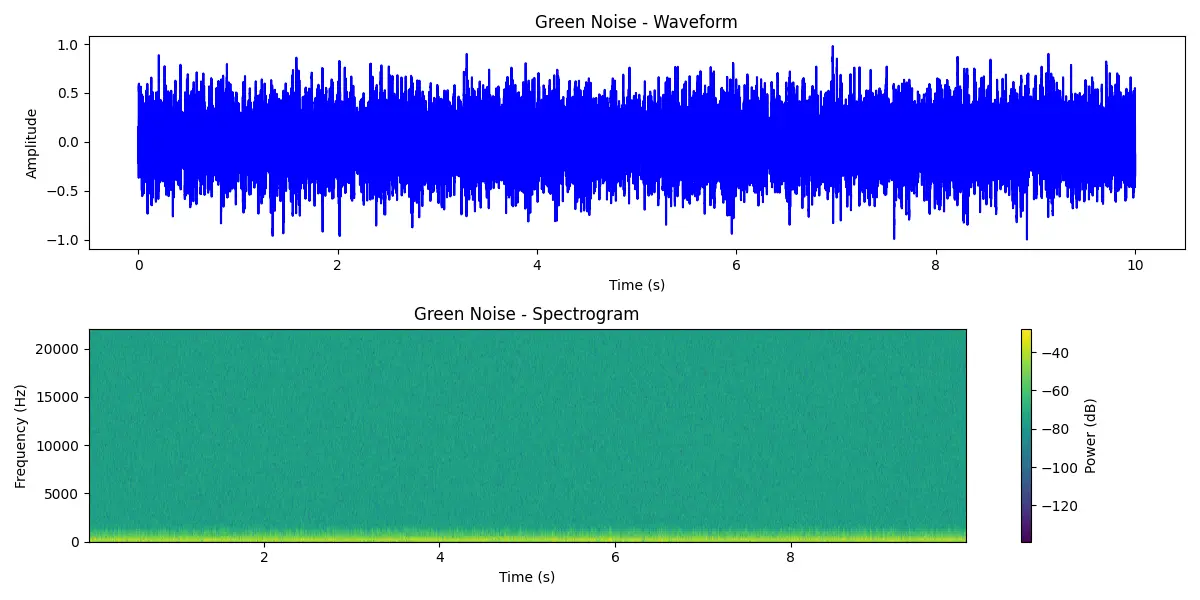
Common Use Cases
Green noise is particularly effective for creating a peaceful environment, whether you’re meditating, unwinding after a long day, or trying to fall asleep. Its softer tones can help reduce stress and promote a sense of calm.
Key Differences Between Green Noise and White Noise
Frequency Range
White noise covers the entire audible spectrum equally, whereas green noise emphasizes mid-range frequencies. This makes green noise sound softer and more natural compared to the sharper tones of white noise.
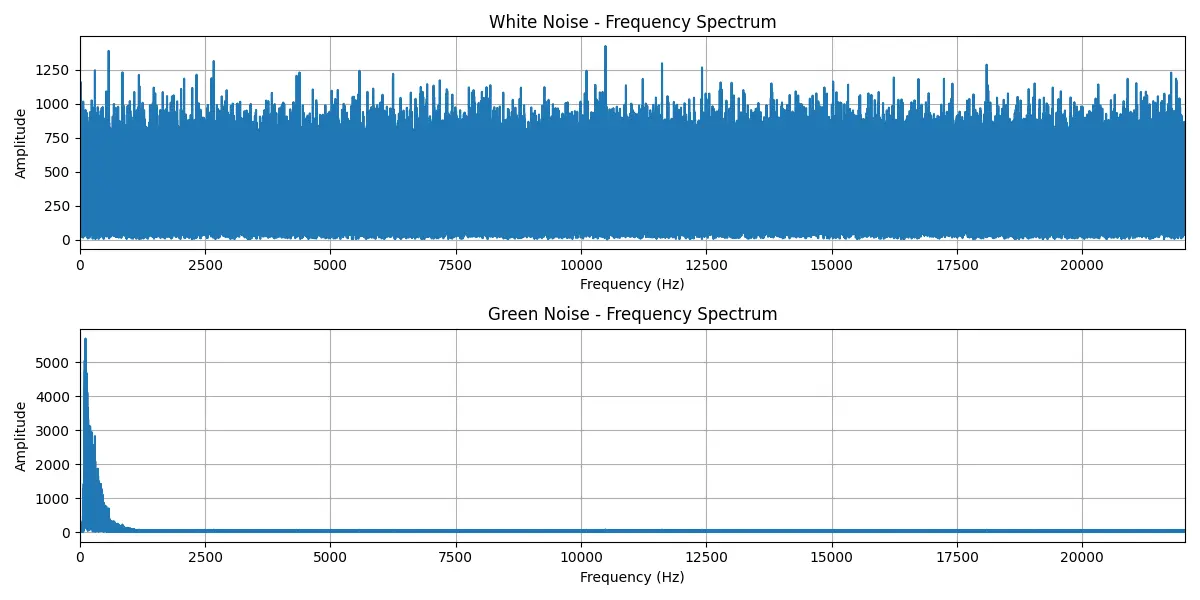
Perceived Sound
White noise has a sharp, static-like quality that can feel harsh to the ears over time, particularly in quieter environments. In contrast, green noise is softer and more soothing, offering a soundscape that mirrors natural ambient noises like gentle winds or distant waterfalls. This distinction makes green noise a preferred choice for relaxation and focus, as its balanced frequencies are less intrusive and create a calming auditory atmosphere.
Spectrogram Analysis
A spectrogram provides a visual representation of sound frequencies over time. When analyzing the spectrogram of white noise, you see a consistent distribution of power across all frequencies, forming a uniform pattern. In contrast, the spectrogram of green noise shows concentrated power in the mid-range frequencies, tapering off at the high and low ends. This difference highlights why white noise is ideal for masking sounds, while green noise feels more natural and calming.
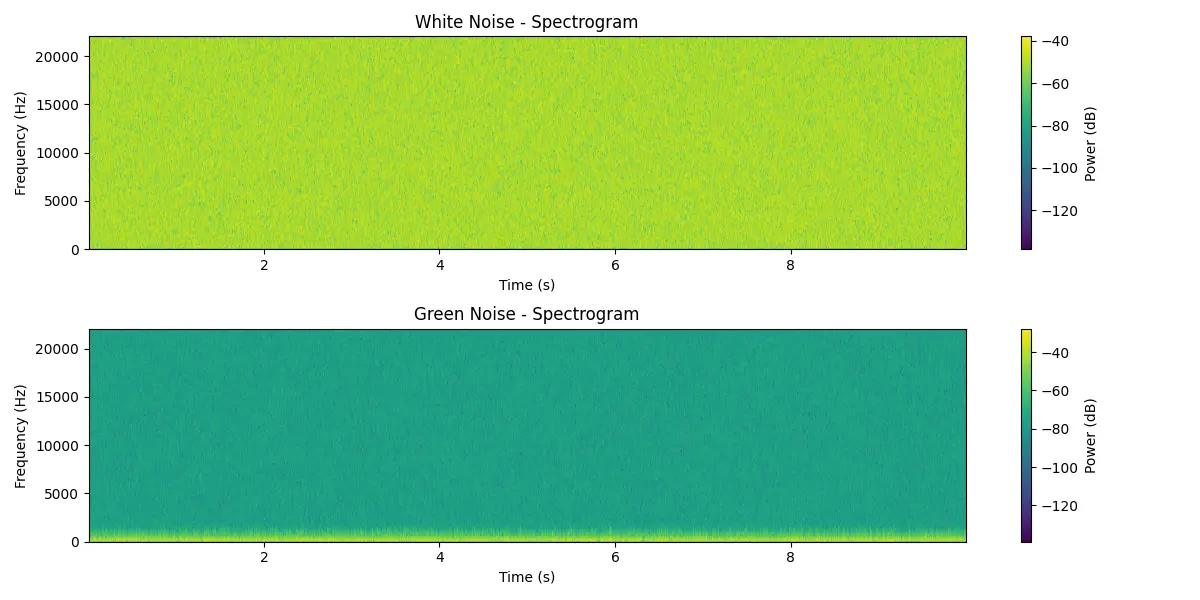
Amplitude Distribution
The amplitude distribution of a sound reveals how its intensity varies over time. White noise has a uniform amplitude distribution, appearing as an even spread of values across its range. Green noise, however, shows a more clustered amplitude distribution, reflecting its focus on mid-frequency sounds. This contributes to the smoother, less grating quality of green noise, making it more pleasant for relaxation.
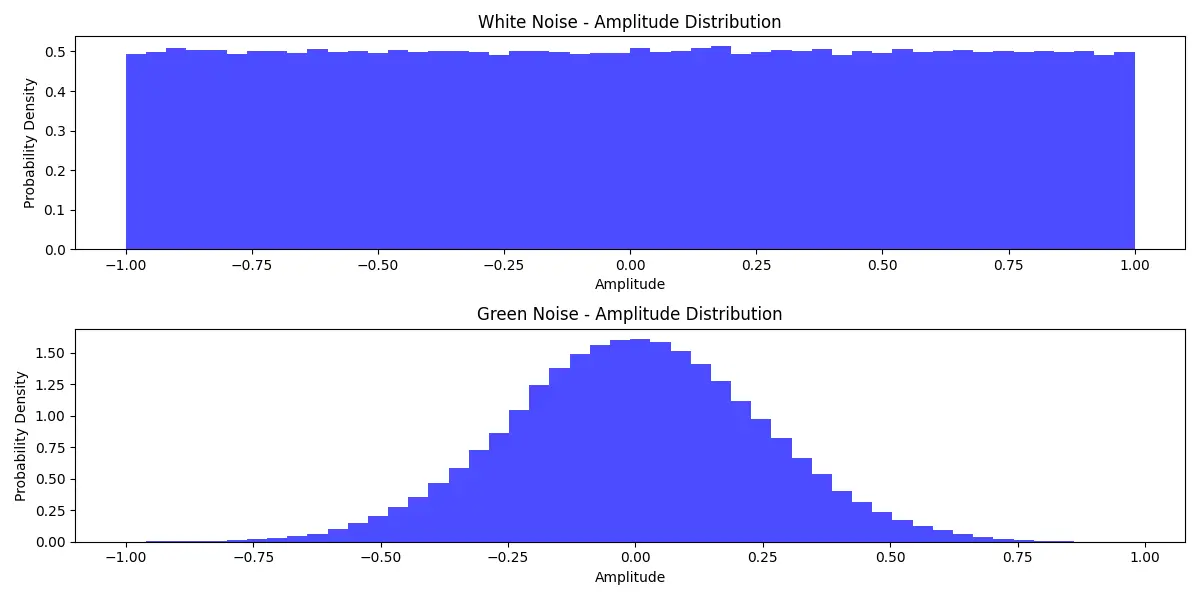
Pros and Cons of Each
White Noise
Pros:
- Highly effective at masking noises, especially sudden or sharp sounds, making it ideal for focus or working in noisy spaces.
- Widely available in various formats, from apps to dedicated machines, ensuring accessibility for different needs and budgets.
Cons:
- Sharp, static-like sound can be grating over prolonged use, potentially leading to discomfort or irritation.
- Lacks the soothing qualities of natural sounds, which may make it less suitable for relaxation or sleep.
Green Noise
Pros:
- Natural and calming tones make it excellent for sleep and relaxation, creating an atmosphere that mirrors the tranquility of nature.
- Balanced frequencies reduce the risk of listening fatigue, making it a gentle option for extended periods of use.
Cons:
- May not mask disruptive sounds as effectively as white noise in loud or unpredictable environments.
- Less variety in available options compared to white noise, potentially limiting its utility for specific use cases.
Which Should You Choose?
For Sleep:
If you’re in a noisy environment, white noise can help drown out external sounds. If your goal is to relax and drift off naturally, green noise may be the better choice.
For Focus:
White noise is excellent for blocking distractions, while green noise creates a peaceful workspace without being overly stimulating.
For Relaxation and Meditation:
Green noise is the clear winner, thanks to its natural and soothing tones that encourage deep relaxation.
How to Try Green Noise and White Noise
Recommendations for Tools
Experiment with tools like green noise players or white noise apps to discover which sound suits you best. A great place to start is the Noisygreen player (noisygreen.com), which offers a variety of green noise types tailored for different activities, whether you’re aiming to relax, focus, or improve your sleep. Exploring these options can help you find the perfect match for your needs.
For white noise, popular apps and devices provide a wide range of options, from portable sound machines to mobile apps. These tools are especially effective in masking background sounds, ensuring uninterrupted sleep or focus. Testing a few tools across different platforms can help you find the perfect match for your lifestyle.
Tips
Spend a few days experimenting with both green noise and white noise in various scenarios. For example, try using green noise while meditating or winding down before bed to see how it influences your relaxation. On the other hand, test white noise in environments with more distractions, like a bustling office or a noisy neighborhood, to evaluate its effectiveness in masking sounds.
Keep a simple log to track how each noise affects your mood, focus, and overall experience. Note if certain noise types improve your concentration during work or help you fall asleep faster. Over time, these observations will guide you in choosing the right noise type for specific situations. Remember, the goal is to find what resonates best with your unique preferences and needs.
Frequently asked questions
Green noise is gaining popularity due to its natural and soothing tones, which resonate with people seeking relaxation or stress relief. Its calming qualities make it ideal for meditation, sleep, and creating a peaceful environment, offering a refreshing alternative to harsher noise types like white noise.
Yes, green noise can help reduce anxiety by creating a calming atmosphere. Its natural, gentle sounds mimic relaxing environments like forests or waterfalls, which can help lower stress levels and promote a sense of tranquility during moments of overwhelm.
The main downside of green noise is that it may not be as effective at masking loud or disruptive sounds compared to white noise. If you're in a particularly noisy environment, you might find green noise less helpful for blocking distractions or ensuring privacy.
You can find green noise tools in the form of dedicated apps, online players, or sound machines. Many platforms offer customizable options tailored for activities like sleep, focus, or meditation, allowing you to choose the type of green noise that best fits your needs.
There’s no strict time limit, but most people find 20–30 minutes of green noise enough to feel relaxed. You can adjust the duration based on your needs, whether it’s a short session to de-stress or a longer period to wind down before sleep. Listen at a comfortable volume to maximize the benefits.
Conclusion
Both green noise and white noise have unique benefits, and the right choice depends on your specific needs. Whether you want to block distractions, improve sleep, or create a calming atmosphere, understanding the differences between these two noise types can help you make an informed decision.
Explore both options and see what works best for you. Don’t forget to try our green noise player for a tailored experience!